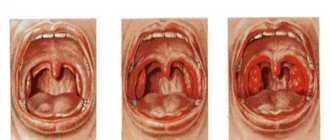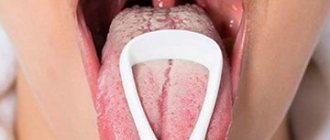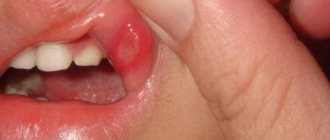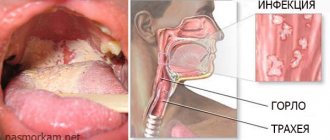Causes of ulcers on the tonsils
Poor oral hygiene leads to the formation of infectious inflammations on the tonsils
An ulcer on the tonsil is a symptom of a disease that needs to be diagnosed. It is often considered as a complication of an undetected and untreated pathology.
The following diseases can provoke the formation of ulcers in the tonsils:
- Angina of gangrenous type. With its development, damage to the mucous membrane of the entire oral cavity is observed. Most often, this problem is faced by people who are worried about an acute form of immunodeficiency. Ulcers are formed due to pathogenic microbes that actively multiply in the mouth.
- Viral sore throat. If the disease is mild, the patient will not be bothered by ulcerative lesions. The risk of its development appears in people who ignore treatment of dental diseases, such as periodontitis.
- Sore throat of bacterial type. From the first days of inflammation, symptoms of necrosis are observed. In this case, ulcers are considered as one of the main signs of the disease.
- Chronic form of tonsillitis. Necrosis occurs in patients who have started the disease, that is, have not begun to fight the root cause of its development in a timely manner. With this diagnosis, patients complain of severe pain, elevated body temperature and apathy.
- Diphtheria tonsils. The pathology is caused by tissue damage by the diphtheria bacillus. The symptoms of the disease directly depend on its stage of development. In both mild and complicated forms of diphtheria, ulcers are observed on the mucous membrane of the organ.
An ulcer on the tonsil is most often a consequence of the above diseases, which occur in children and adults.
Important! Since ulcers can indicate a serious illness, it is strictly forbidden to try to cure them with home methods. With such a symptom, consultation with a specialist is required.
Other reasons can lead to ulcerative lesions of the tonsils:
- Suffered from acute respiratory viral infection, which caused a decrease in the body's defenses.
- Heart disorder.
- Dysfunction of the hematopoietic system.
- Decreased vascular tone.
- Vitamin deficiency.
- Irregular brushing of teeth and rinsing the mouth.
- Syphilis of the second degree.
If a person has these problems, then he must take measures to prevent the formation of ulcers in the tonsils, as he automatically falls into the risk group.
Stomatitis in the throat: symptoms and treatment
Stomatitis is a widespread dental disease. It affects the oral cavity, sometimes the tonsils and pharynx. Stomatitis in the throat significantly complicates the process of eating and simply gives the patient a lot of unpleasant sensations.
Pain when swallowing, burning and constant discomfort, severe swelling of the affected area are only the main symptoms of the pathology. Ulcers on the tonsils are difficult to treat due to their specific location.
Read more about stomatitis in the throat, the characteristics of its course and treatment in our review.
Symptoms of stomatitis in the throat: red sores on the tonsils, pain when swallowing
As with other forms, stomatitis in the throat area is characterized by a general deterioration in well-being and the appearance of the following symptoms:
- burning – in the mouth, throat;
- unpleasant odor (not always present);
- red tonsils and oral cavity;
- swelling of the mucous membranes and larynx;
- decreased appetite and/or difficulty eating;
- increased body temperature, headache;
- increased amount of saliva.
If you start treatment for the disease in the early stages, coping with the disease will be quite simple. The doctor examines the patient, asks him about his complaints and draws up a treatment plan. The main indicators of stomatitis in the throat are a characteristic coating on the surface of the tongue, stomatitis on the tonsils, whitish formations in the throat, enlargement or inflammation of the lymph nodes.
It is highly not recommended to treat throat ulcers on your own. At best, this will simply not give you anything, and at worst, you will start the inflammatory process, and it will be difficult to do anything later.
Causes of occurrence on the tonsils
The main causes of stomatitis:
- Allergy to a number of products.
- Throat infection.
- Injuries to the tonsils or mucous membranes.
Often stomatitis develops against the background of acute respiratory viral infections and tonsillitis, sometimes they are caused by the herpes simplex virus (it only needs to enter the body once - it remains in the blood forever).
Also, this pathology is a faithful companion of weakened immunity, cancer, gastrointestinal diseases, and general serious damage to the body. The forms of the course are acute and chronic, which differ in symptoms and characteristics of the course.
Acute always develops first, but if you do nothing, then over time it will become chronic.
Kinds
Stomatitis in the throat, unlike stomatitis in the palate, appears as a result of an atypical reaction of the body's defenses to irritants with the formation of ulcers. It is for this reason that pathology often manifests itself against the background of a sluggish systemic infection.
Viral
Viral stomatitis is caused by the herpes virus, which is constantly present in the body of most of us. Infection of a healthy person occurs as a result of contact with a carrier of a viral infection. Signs of the disease may vary depending on the state of immunity and the age of the patient.
The main symptoms are the appearance of blisters (they are localized in groups), redness of the mucous membranes, the formation of wounds, enlarged lymph nodes, fatigue, and increased body temperature. The chronic form of the pathology is characterized by very frequent relapses. Learn about angular stomatitis and methods of its treatment in this material.
Pregnant women and children are at risk of contracting viral stomatitis.
Bacterial
This form of stomatitis in the throat is caused by streptococci and staphylococci. These microorganisms live in the oral cavity in significant quantities in diseases of the gums, teeth, nasopharynx, and tonsils.
Also, the reason may be unsatisfactory oral hygiene; a lesion develops against the background of a recent sore throat.
Microbes can also land on wounds on the skin of the face, lips, and then move into the oral cavity.
An infection can be caused by a dentist during treatment of teeth and gums.
The first symptoms of the bacterial form of stomatitis of the throat are pain when eating spicy and sour foods, swelling, redness of the affected area, ulcers, cracks, increased salivation, and an unpleasant odor.
If treatment is not started, soft tissues will begin to die, body temperature will rise, general weakness will develop, severe migraines and constant pain in the throat may begin.
Fungal
Fungal stomatitis is caused by corresponding fungi (the most common is Candida). They are constantly present in the body and in small quantities do not cause harm to health.
Problems begin when using antibiotics, hormonal drugs and other medications that promote the proliferation of these microorganisms.
Find out why teeth decay and what you need to do to protect them here.
The first sign of candidal stomatitis is dysbacteriosis.
A white coating appears on the palate, tongue, and throat, and when removed, inflamed red spots remain. The middle stage is characterized by the presence of deposits that are similar in appearance to cottage cheese.
If left untreated, a thin film will begin to form on the mucous membranes over time, covering the soft tissues of the oral cavity. The average duration of treatment is from a week to one month. Children usually refuse to eat and become capricious.
Diagnostic methods
When a patient first seeks help, the doctor examines the oral cavity, assesses the severity of symptoms, and determines the timing and characteristics of the course of the disease. It is also necessary to clarify the presence of allergic reactions to certain substances, recent infectious diseases, injuries, and the quality of personal hygiene.
In medicine, there are no special tests that should confirm this or that type of stomatitis.
If necessary, your doctor may refer you for additional tests. Basic:
- Blood test for glucose - it shows diabetes mellitus, a frequent companion and provocateur of stomatitis.
- Bacterial culture - its results allow us to determine the type of infection contained in the body and prescribe the correct, most effective treatment.
- PCR is the most accurate diagnostic method that determines the presence of influenza viruses, herpes, enterovirus, and chickenpox. Additionally, differential diagnosis is required - it will allow us to exclude types of diseases with similar symptoms. Frequent relapses of stomatitis may indicate the presence of the HIV virus.
Treatment
For stomatitis of the throat, treatment should be comprehensive.
It involves the use of painkillers, anti-inflammatory drugs, frequent drinking, avoiding general overheating of the body and excessive physical activity, rinsing with salt and iodine.
Since the form of the pathology is quite complex, self-medication almost never gives the required results. Read about the treatment of ulcerative stomatitis in the mouth here.
Medication
The first method of treating stomatitis of the throat is medication.
Anesthesia
Anesthetics and painkillers do not cure ulcers, but they significantly alleviate the patient’s condition. They also protect open areas from contact with irritants and, accordingly, additional trauma and deterioration of well-being. This link will tell you how to relieve toothache during pregnancy.
It is recommended to use disinfectants together with anesthetics. The main drugs are Benzocaine, Kamistad, Anestezin, Trimecaine, Lidocaine, Cholisan.
At elevated body temperatures, antipyretics are additionally prescribed.
Antiseptics
Rinsing and applications with anesthetic solutions relieve pain, which is important for ulcerative forms of stomatitis, and helps maintain normal appetite. Preparations - peroxide, potassium permanganate, Miramistin, Chlorhexidine, Solcoseryl.
You can also use antiseptic sprays that stop oxidative reactions in bacterial cells, thereby preventing the active synthesis of amino acids in fungal cultures (Hexoral, Hepilor, Proposol).
Blue is also used for antiseptic action.
Antibiotics
Antibiotics are rarely used in the treatment of inflammation of the oral mucosa - with frequent relapses, lack of treatment results, or transition of the pathology to a severe form. You can use the drugs in ointments and tablets.
Popular antibiotics are Amoxiclav, Sumamed, Augmentin, Amoxicycline. Please note that antibiotics are recommended to be used in combination with healing agents (for example, ointments with propolis and sea buckthorn oil).
Healing drugs
For healing purposes, it is recommended to lubricate ulcerative formations with trimecaine, lidocaine, Metrogil Dent, benzocaine, and aloe juice. The active substances cover the eroded parts with a thin protective film.
Drugs of this group cannot be used for a long time. Good results are obtained by using drugs that cleanse ulcers from bacterial plaque (it is this that prevents normal healing of wounds).
Cleaning pastes with hydrogen peroxide or carbamide are shown.
Immunostimulants
Immunostimulants contain synthetic, plant and biological substances and are used to treat a wide range of pathologies. These drugs are safe and rarely cause side effects, and are easily eliminated from the body.
The intensity of action may vary, so the choice of remedy should be made by a doctor. The main drugs are Derinat, Imudon, Immunal.
ethnoscience
Rinsing the mouth with herbal decoctions and lotions speed up the healing process and help to recover faster from stomatitis of the throat. Popular recipes:
- Gargling with hydrogen peroxide – two teaspoons per glass of water.
- Chewing aloe leaves.
- Rinsing the throat with 50% propolis tincture.
- Compresses with yogurt and garlic (you can lubricate the throat with the mixture). To prepare them, take two spoons of yogurt and three cloves of garlic.
- Rinse with freshly squeezed carrot juice.
- Rinse with chamomile infusion.
For sore throat, it is recommended to gargle with warm water every time after eating.
Complications and their prevention
Throat stomatitis is a rather dangerous pathology that requires timely, competent treatment to avoid spreading to neighboring tissues and organs. The inflammatory process often causes an increase in overall body temperature, weakening of the body, and can lead to the destruction of the bone structures of the jaw and tooth loss.
Due to swelling of the trachea and throat, breathing problems may occur, including asphyxia.
Therefore, take care of oral hygiene, avoid damage to the mucous membranes, promptly treat pathologies of the gums and teeth, refrain from contact with carriers of infections, and avoid stress.
Visit your dentist regularly - he will promptly detect existing problems and provide qualified treatment. This article will tell you how to get rid of bad breath during pregnancy.
: how to quickly cure stomatitis in the throat and mouth
For more useful information about methods for eliminating stomatitis, watch the video
Conclusion
- Throat stomatitis is a severe form of the disease, which causes a lot of inconvenience to the patient.
- To treat stomatitis in the throat and cheek, medications and folk remedies are used.
- In addition to the examination, the doctor may ask for test results (for example, PCR, culture).
- Treat throat stomatitis in a timely manner, as it is fraught with very serious complications.
Source: https://ZubZdorov.online/bolezni/chelyusti-i-polosti-rta/stomatit/formy/lokalizatsiya/v-gorle.html
Types of lesions
Doctors distinguish several types of ulcerative lesions of the tonsils. Pathology can take the following forms:
- Medication. The reason for the appearance of a large number of ulcers on the tonsils is the failure of the human body to take the medications that he must take for the whole course.
- Primary herpetic. It is considered the most common form. It is more often noticed in children rather than adults. Unknowingly, parents may confuse sores with ordinary herpes.
- Candida. The lesion is caused by the active growth of a yeast-like fungus in the oral cavity.
- Traumatic. Ulcers form on the mucous membrane after it is damaged. Most often, swallowing hot food leads to this result.
- Infectious. A person becomes infected with an infection from other people or animals. The progression of the disease leads to complications, including ulcerative lesions of the tonsils.
- Ulcerative-necrotic. Pathology occurs due to pathogenic bacteria entering the oral cavity. This problem is faced by people with weakened immune systems.
- Allergic. One of the rare forms of tonsil ulcers. Usually occurs when consuming a product or medication to which there is an individual intolerance.
As a rule, ulcers on the tonsils accompany the development of another disease, for example, stomatitis or tonsillitis. They cannot appear by themselves. There must be a factor that leads to such an outcome.
Treatment
Treatment is prescribed depending on the diagnosis. An otorhinolaryngologist will tell you in detail how and how to treat sores in a child’s throat.
If the disease is caused by a fungus, antifungal drugs are prescribed. If a bacterial infection is detected, the patient undergoes antibacterial therapy. Treatment must be comprehensive. It includes diet, drug and non-drug therapy, physiotherapy, and traditional medicine.
Initially, a diet is prescribed. Products should be high in vitamin B12 (beef, beef liver and heart, dairy products); vitamin E (carrots, broccoli, oatmeal, cucumbers); folic acid (cheeses, poultry). All food should be served in the form of purees or pureed soups so as not to injure a sore throat. Spicy, salty, sweet, and sour foods should be avoided.
Drug treatment must be appropriate to the diagnosis.
Table. Medicines:
| Antibiotics | Antifungal drugs | Local anti-inflammatory drugs | Antiseptics |
| Amoxiclav is a powder for preparing a suspension. Active ingredients: amoxicillin, clavulanic acid. Has a wide spectrum of antibacterial action. Used to treat infections of the upper and lower respiratory tract. | Bioparox is an aerosol for inhalation. The active ingredient is fusafungin. Active against fungi of the genus Candida. | Lugol is a spray or solution that is used topically. The active ingredient is iodine. It is used for infectious and inflammatory diseases of the oropharynx in adults and children. | Hydrogen peroxide - used externally. Promotes mechanical cleansing of the mucous membrane. Used for washing and rinsing for sore throats and stomatitis. |
| Doxycycline is available in capsules. The active ingredient is doxycycline hydrochloride. Used for respiratory tract infections. |
Each pack includes instructions for ease of use. The price of the drugs is low and affordable for everyone. In the absence of contraindications, the doctor may prescribe physiotherapy, such as quartz treatment and heating.
When using traditional medicine recipes, you must consult a doctor. In many cases, it does a good job in fighting diseases. Medicines can be prepared with your own hands from available means.
Here are some simple recipes:
- Brew a small handful of chamomile with a glass of boiling water. Let it brew. Gargle with warm infusion several times a day for a week;
- carrot juice. Squeeze the juice from carrots, dilute with water and gargle every hour;
- You can chew aloe or kalanchoe leaves. Or crush the leaves to a paste and lubricate the affected throat;
- tea mushroom. You can drink half a glass four times a day, or lubricate your throat hourly.
You can learn more about traditional medicine recipes from the video in this article. With proper treatment, ulcers in a child’s throat will disappear quite quickly. And the lack of treatment often leads to the development of serious complications.
Source: gorlor.com
Symptoms
Eating food and water is accompanied by discomfort
Ulcers may appear on the tonsils without fever. At the same time, a person experiences symptoms of malaise, which make it possible to identify the root cause of the painful condition.
The following signs help to suspect the appearance of ulcers on the tonsils:
- Normal body temperature. If it exceeds the permissible limits, it means that we are talking about a severe course of the pathology, the timely treatment of which was missed.
- Enlarged lymph node at the site of the inflammatory process.
- The presence of white plaque on the tonsils, which can be removed without much effort. He covers up the ulcer.
- Slight soreness in the throat.
- Sensation of a foreign body in the throat.
- Bad breath.
- Increased salivation.
If you notice such symptoms, it is strongly recommended to seek medical help. This will allow you to diagnose the disease in a timely manner and cope with it safely.
Diagnostics
Ulcers located on the tonsils are identified during diagnostic procedures.
When you first visit a doctor, you need to tell him in detail about your symptoms. It is also important to provide information about medications taken in the past few days, as this may influence the choice of drug therapy.
The attending physician determines ulcers on the tonsils by performing the following diagnostic methods:
- Examination of the throat.
- Palpation of lymph nodes.
- General blood analysis.
- Study of immune reactions.
- Throat swab.
- Antibioticogram.
The last diagnostic option is intended to determine the causative agent of the disease that led to the formation of ulcers in the throat.
Treatment methods for ulcers on the tonsils
You should not self-medicate, otherwise it can only worsen the situation.
The doctor will explain how to treat ulcerative lesions of the tonsils, with whom you must make an appointment if a problem is detected.
You cannot treat an ulcer on your child’s tonsils on your own. Until consultation with a specialist, it is forbidden to give anything to the baby, as this may worsen his condition.
Treatment of ulcers on the tonsils can be medicinal and physiotherapeutic. With the permission of a doctor, it is also permissible to use traditional medicine methods that give good results.
Drug therapy
In most cases, ulcers on the tonsils can be treated with medication. To eliminate the pathology, you will need to take drugs from several drug groups:
- Antibiotics.
- Antipyretic.
- Anti-inflammatory.
- Analgesics.
- Antifungal.
The choice of drugs directly depends on what caused the white deposits in the form of plaque and ulcers in the throat.
The dosage of medications and the duration of their use are determined by the attending physician who diagnosed the patient. Without his knowledge, it is prohibited to make adjustments to the course of therapy, as this may adversely affect its effectiveness.
Most drugs cause side effects. Therefore, the patient must carefully monitor his condition while taking them. And then the treatment will go according to plan. If during therapy the patient’s well-being begins to deteriorate, his attending physician will have to think about changing the medication.
Physiotherapeutic method of treatment
The doctor decides how to treat ulcers in the throat in the area where the tonsils are located. At his discretion, he may suggest physical therapy. Its action is aimed at improving the patient’s health and preventing relapses of the disease.
During remission, a course of laser therapy and ultraviolet irradiation of the tonsils is proposed.
Folk remedies to help
The drink must be drunk whole, at once, without dividing it into parts and without leaving
Traditional treatment methods can be combined with folk remedies if the patient has no contraindications to them.
Regular rinsing of the mouth with decoctions based on mint, oak bark, chamomile and eucalyptus has a good effect. Plants can be used individually or in combination with each other.
The following folk remedies help to cope with ulcers in the tonsils more quickly:
- A mixture of kefir, lemon juice and beets. The healing product must be taken for ulcers twice a day. The process of its preparation is simple. You need to mix the juice of ½ lemon, a glass of kefir, 3 tbsp. l. beet juice and 1 tsp. rosehip syrup. The main components of the medicine must be thoroughly mixed. The entire prepared portion is taken at one time.
- Herbal tea. It is recommended for colds. Also helps heal mouth ulcers. Raspberry leaves and linden honey are used to prepare the drink. The last ingredient is added to the tea after it has cooled slightly.
Before using this folk remedy, you must make sure that there are no contraindications to the products that are present in the composition.
Antihistamines
Stomatitis is a disease of an allergic nature, since its manifestations are the body’s reaction to certain external stimuli. In this case, pathogenic bacteria. Therefore, taking antihistamines is justified in most cases. These remedies will help you quickly get rid of the unpleasant manifestations of the disease and speed up the activity of the body's defenses.
We invite you to familiarize yourself with Blisters in the throat on the back wall - photos, what they are, how to treat them
Immunomodulator drugs will help bring immunity to a higher level. Therefore, be sure to take these medications, and recovery will not take long.
Why there is pain in the tonsil on one side and how you can get rid of such a problem is described in this article.
But why plaque appears on the tonsils in a child with a fever and how you can reduce inflammation and subsequently get rid of such a problem is very well described in this article.
But how to treat inflammation of the tonsils in a child and with what means is described in detail in this article: purulent plugs in the tonsils without fever are treated and what treatment is the most effective is described in this article.










